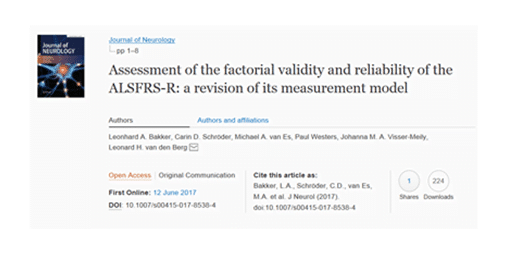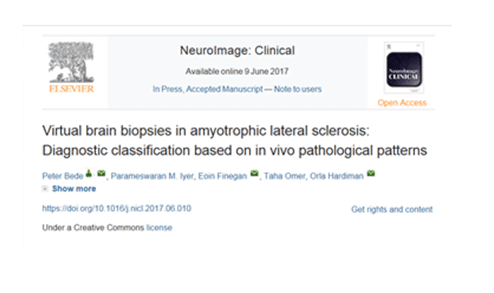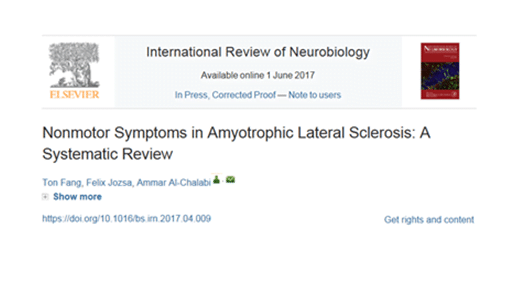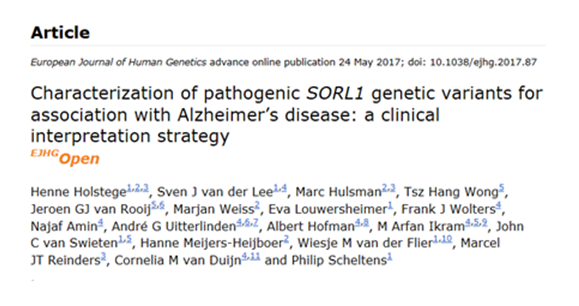 „Assessment of the factorial validity and reliability of the ALSFRS-R: a revision of its measurement model“ has been published in Journal of Neurology. This work has been supported in part by JPND through the SOPHIA project, selected in the 2011 Biomarkers call, the STRENGTH project, selected in the 2012 Risk Factors call and the ALS-CarE project, selected in the 2012 Healthcare Evaluation call.
„Assessment of the factorial validity and reliability of the ALSFRS-R: a revision of its measurement model“ has been published in Journal of Neurology. This work has been supported in part by JPND through the SOPHIA project, selected in the 2011 Biomarkers call, the STRENGTH project, selected in the 2012 Risk Factors call and the ALS-CarE project, selected in the 2012 Healthcare Evaluation call.
Yearly Archives: 2017
Researchers have succeeded in analysing the effects of selective mutations of the alpha-synuclein protein, a protein that is closely linked to Parkinson’s disease. Examining the effects of changing a single amino acid in the protein, the physicochemists were able to show how this tiny change disturbs the binding of alpha-synuclein to membranes.
This study was published in the Journal of the American Chemical Society.
The human brain contains large quantities of the small alpha-synuclein protein. Its exact biological function is still unknown, yet it is closely linked to Parkinson’s disease; the protein „clumps together“ in the nerve cells of Parkinson patients. Alpha-synuclein consists of a chain of 140 amino acids. In rare cases Parkinson’s disease is hereditary; where this occurs one of these 140 components has been replaced. A team of scientists have now found out the influence these selective changes in the protein sequence can have on the behaviour of alpha-synuclein.
To find out more about the influence of selective mutations, the researchers applied tiny magnetic probe molecules to various places on the alpha-synuclein protein. With the help of electron paramagnetic resonance spectroscopy — a procedure similar in method to magnetic resonance imaging (MRI) used in the medical field — the researchers were able to measure the rotation of these nanomagnets. At every residue at which alpha-synuclein binds to a membrane, the rotation slows down. In this way they were able to find out precisely when and where a binding to the membranes takes place — and when it does not. In the case of the exchanged amino acids the physicochemists from Konstanz discovered a disturbance of the membrane binding of alpha-synuclein — an important clue for the molecular context of Parkinson’s disease.
Paper: “Alpha-Synuclein Disease Mutations Are Structurally Defective and Locally Affect Membrane Binding”
Reprinted from materials provided by the University of Konstanz.
 „Virtual brain biopsies in amyotrophic lateral sclerosis: Diagnostic classification based on in vivo pathological patterns“ has been published in the journal Neurolmage: Clinical. This work was supported in part by JPND through the SOPHIA project, selected in the 2011 Biomarkers call.
„Virtual brain biopsies in amyotrophic lateral sclerosis: Diagnostic classification based on in vivo pathological patterns“ has been published in the journal Neurolmage: Clinical. This work was supported in part by JPND through the SOPHIA project, selected in the 2011 Biomarkers call.
Scientists have identified a common mechanism in two forms of neurodegeneration that affect young adults or the elderly: frontotemporal dementia (FTD) and neuronal ceroid lipofuscinosis (NCL).
This study was published in the journal Science Translational Medicine.
FTD is one of the most common forms of dementia in adults under 65 years. NCL is the most common neurodegenerative disease in children and young adults. This condition is associated with lipofuscin, the excessive accumulation of fats and proteins called lipopigments in vulnerable cells and tissues of the body.
The common factor in these diseases is the protein progranulin. Progranulin is involved in many biological processes, including inflammation, tumor formation, and normal development. It is widely expressed in the body, but changes in its expression mostly affect the brain. When progranulin levels are low, brain cells die more readily when exposed to toxins. Mutations that lower progranulin levels cause FTD, whereas complete loss of progranulin leads to NCL.
The researchers took a close look at lipofuscin in humans who carry mutations in the progranulin gene. Because vision loss is one of the first symptoms of NCL, and it is accompanied by lipofuscin accumulation in the retina, the researchers first evaluated lipofuscion in the retina using confocal scanning laser ophthalmoscopy. This non-invasive imaging technique is routinely performed in patients in the clinic.
After this initial discovery, the scientists evaluated the frontal cortex, the region of the brain most affected in FTD. Using postmortem tissues, the team found that lipofuscin deposits also accumulated in neurons from the frontal cortex of people carrying progranulin mutations.
To diagnose NCL, patients often undergo testing to determine the amount of lipofuscin in peripheral blood lymphocytes, a type of white blood cell. The researchers found higher levels of NCL-like lipofuscin in lympohblasts, cells that mature into lymphocytes,in patients with NCL, and also in asymptomatic patients carrying mutations in the progranulin gene. They then restored progranulin levels to normal in these cells, which reduced the levels of NCL-like lipofuscin.
Future studies will clarify if lipofuscin itself causes disease and whether progranulin directly contributes to lipofuscin accumulation and neuronal loss.
Paper: “Individuals with progranulin haploinsufficiency exhibit features of neuronal ceroid lipofuscinosis”
Reprinted from materials provided by Gladstone Institutes.
 „Major hnRNP proteins act as general TDP-43 functional modifiers both in Drosophila and human neuronal cells“ has been published in the journal Nucleic Acids Research. This work was supported in part by JPND through the RiMod-FTD project, selected in the 2012 Risk Factors call.
„Major hnRNP proteins act as general TDP-43 functional modifiers both in Drosophila and human neuronal cells“ has been published in the journal Nucleic Acids Research. This work was supported in part by JPND through the RiMod-FTD project, selected in the 2012 Risk Factors call.
Scientists have identified that mutations in a protein commonly linked to frontotemporal dementia (FTD) result in obsessive-like behaviors. They linked these behaviors to immune pathways, implicating that targeting key components of the immune system could be a new therapeutic strategy for FTD.
The study was published in the journal Proceedings of the National Academy of Sciences.
FTD is a common form of dementia in people under 65 years of age. Its symptoms include marked disturbances in language and debilitating changes in behavior, including loss of social awareness and impulse control. There is no cure for FTD, but by better understanding what underlies the symptoms of the disease, researchers believe that they will move closer to a cure.
Research has already shown that mutations in the protein progranulin are linked to some forms of FTD, but how progranulin is involved in the changes to behavior was not clear. The researchers had some hints from previous work: mice lacking progranulin groom themselves excessively, similar to obsessive behaviors seen in FTD patients who have mutated progranulin. Those mutations also result in too much of an inflammatory signal called TNFa, and FTD patients have an increased risk of autoimmune disorders in which TNFa has been implicated. From these key pieces of information, the research team wondered how the immune system, and TNFa in particular, might be involved in FTD.
They began their study by using genetic methods to delete the gene for TNFa in mice that lacked progranulin. Interestingly, removing TNFa stopped the excessive grooming.
They then examined resident immune cells in the brain called microglia. These cells use their long processes to „feel around“ neurons and their surroundings to ensure a proper „working environment.“ If they detect a damaged neuron or an infection, they become mobilized to take up neuronal debris or pathogens, and they secrete chemical signals to attract other microglia to help deal with the problem.
The scientists used genetic methods to delete progranulin specifically from microglia, which induced excessive self-grooming in the mice. This finding established, for the first time, that microglia regulate obsessive behaviors. Those behaviors could be prevented by inactivating a master regulator of the immune system, NF-kB, in microglia.
Reducing NF-kB activity in immune cells yielded another important result. Mice lacking progranulin are not as social as normal mice, and this feature is quite similar to a behavior in FTD patients, who become socially withdrawn. Reducing NF-kB levels in immune cells not only reduced excessive grooming, but it also improved the social behavior of the mice lacking progranulin. This suggests that NF-kB may be at the center of the behavioral abnormalities observed in FTD.
Paper: “Microglial NFκB-TNFα hyperactivation induces obsessive–compulsive behavior in mouse models of progranulin-deficient frontotemporal dementia”
Reprinted from materials provided by Gladstone Institutes.
 „A protocol for manual segmentation of medial temporal lobe subregions in 7 tesla MRI“ has been published in the journal NeuroImage: Clinical. This work was supported in part by JPND through the EUFIND project, selected in the 2016 Brain Imaging Working Groups call.
„A protocol for manual segmentation of medial temporal lobe subregions in 7 tesla MRI“ has been published in the journal NeuroImage: Clinical. This work was supported in part by JPND through the EUFIND project, selected in the 2016 Brain Imaging Working Groups call.
Data from the Framingham Heart Study has shown that people who consistently sleep more than nine hours each night had double the risk of developing dementia in 10 years as compared to participants who slept for 9 hours or less. The findings, published in Neurology, also found those who slept longer had smaller brain volumes.
A large group of adults enrolled in the Framingham Heart Study (FHS) were asked to indicate how long they typically slept each night. Participants were then observed for 10 years to determine who developed dementia, including dementia due to Alzheimer’s disease. Researchers then analyzed the sleep duration data and examined the risk of developing dementia.
According to the researchers the results suggest that excessive sleep may be a symptom rather than a cause of the brain changes that occur with dementia. Therefore, interventions to restrict sleep duration are unlikely to reduce the risk of dementia.
The researchers believe screening for sleeping problems may aid in the early detection of cognitive impairment and dementia. The early diagnosis of dementia has many important benefits, such as providing a patient the opportunity to more activity direct their future plans and health care décisions.
Paper: “Prolonged sleep duration as a marker of early neurodegeneration predicting incident dementia”
Reprinted from materials provided by the Boston University Medical Center.
 „Characterization of pathogenic SORL1 genetic variants for association with Alzheimer’s disease: a clinical interpretation strategy“ has been published in the European Journal of Human Genetics. This work was supported in part by JNPD through the PERADES project, selected in the 2012 Risk Factors call.
„Characterization of pathogenic SORL1 genetic variants for association with Alzheimer’s disease: a clinical interpretation strategy“ has been published in the European Journal of Human Genetics. This work was supported in part by JNPD through the PERADES project, selected in the 2012 Risk Factors call.
Huntington’s disease is caused by a gene mutation that causes an abnormal form of the protein huntingtin to build up in the brain. Small chemical modifications on different parts of huntingtin could reduce its toxicity and aggregation, but as many enzymes already chemically modify the protein in the cell, it has been difficult to determine what chemical modifications could serve as future therapies.
In a world first, scientists have now developed synthetic methods that allow site-specific chemical modifications on huntingtin while bypassing the need to identify the enzymes behind them.
The study was published in Angewandte Chemie.
After being produced by its gene, the huntingtin protein is subjected to numerous chemical changes, during which enzymes in the cell attach different chemical groups to it, such as phosphate (phosphorylation) or acetylene (acetylation). These changes are called „post-translational modifications“ but the key molecular players that regulate them remain unknown.
To address this knowledge gap and explore the therapeutic potential of post-translational modifications, a group of researchers turned to chemistry and developed synthetic strategies that allow site-specific introduction of chemical modifications. The new strategy combines chemical and bacterial synthesis of proteins to generate a part of mutant huntingtin where many important post-translational modifications take place. This segment is known as „mutant hutingtin exon1“ (Httex1) and has been shown to be sufficient for reproducing key features of Huntington’s disease in animal models.
Using the method, the researchers could now generate all the known modified forms of huntingtin in very pure and homogeneous forms.
The researchers explored how these modifications can act as molecular switches that can be exploited to regulate Huntingtin structure, function and toxicity. In this vein, they made three discoveries regarding the relationship between post-translational modifications of Huntingtin and its structure.
First, phosphorylation of threonine on position 3 (T3) stabilizes a helical formation of huntingtin’s first 17 amino acids, and interferes with its ability to aggregate. This could explain why this particular modification is reduced in Huntington’s disease and suggest that modulating the level of this modification could protect against HD disease.
Second, the study found that substituting threonine with another amino acid (glutamate or aspartate) to mimic the charge of the phosphate group, does not fully reproduce the effects of genuine phosphorylation on the structure and aggregation of huntingtin. This is important for biologists who, in the absence of knowledge about the key enzymes that regulate phosphorylation, use this substitution as a go-to solution.
Finally, the scientists were able for the first time to study the impact of acetylation, which takes place on three Lysine amino acids of huntingtin. While acetylation of individual residues did affect huntingtin’s structure or aggregation, acetylation at one lysine (in position 6) did reverse the protective effect of T3 phosphorylation when the two modifications were introduced simultaneously.
The researchers say that their study highlights the importance of better understanding the enzymes that regulate huntingtin modifications and note that their research could lead to the establishment of new biomarkers for disease diagnosis and monitoring.
Paper: “Mutant Exon1 Huntingtin Aggregation is Regulated by T3 Phosphorylation-Induced Structural Changes and Crosstalk between T3 Phosphorylation and Acetylation at K6”
Reprinted from materials provided by Ecole Polytechnique Fédérale de Lausanne.
